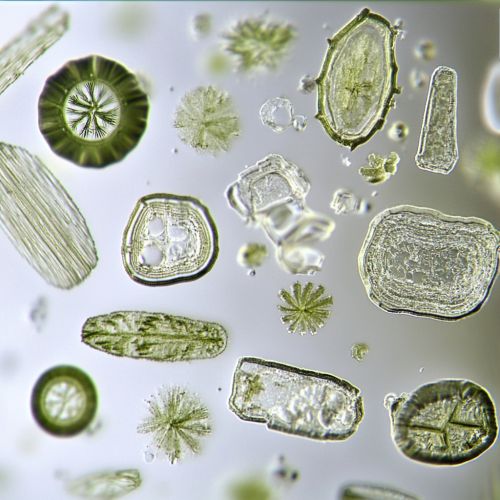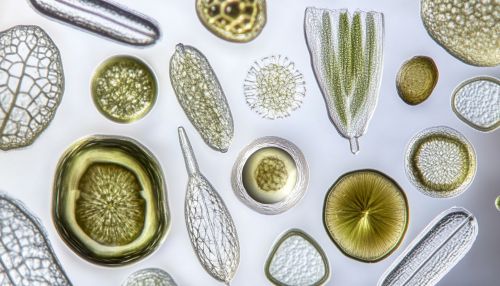Phytolith: Difference between revisions
(Created page with "== Introduction == Phytoliths are microscopic silica structures that form within the cells of many plants. These structures are highly durable and can persist in soils and sediments long after the plant has decayed, providing valuable information for archaeology, paleoecology, and botany. Phytoliths are composed primarily of silicon dioxide (SiO2), which is deposited in and around plant cells, creating a unique and resilient record of plant life. == Formati...") |
No edit summary |
||
| Line 45: | Line 45: | ||
Future research may focus on expanding phytolith reference collections, improving classification systems, and exploring the potential of phytoliths in new areas of study, such as forensic science and climate change research. | Future research may focus on expanding phytolith reference collections, improving classification systems, and exploring the potential of phytoliths in new areas of study, such as forensic science and climate change research. | ||
[[Image:Detail-98303.jpg|thumb|center|Microscopic view of various phytolith shapes and structures.|class=only_on_mobile]] | |||
[[Image:Detail-98304.jpg|thumb|center|Microscopic view of various phytolith shapes and structures.|class=only_on_desktop]] | |||
== See Also == | == See Also == | ||
Latest revision as of 21:39, 8 October 2024
Introduction
Phytoliths are microscopic silica structures that form within the cells of many plants. These structures are highly durable and can persist in soils and sediments long after the plant has decayed, providing valuable information for archaeology, paleoecology, and botany. Phytoliths are composed primarily of silicon dioxide (SiO2), which is deposited in and around plant cells, creating a unique and resilient record of plant life.
Formation and Composition
Phytoliths form through the uptake of soluble silica from the soil by plant roots. This silica is transported through the plant and deposited within the cells as solid silica bodies. The process of phytolith formation is influenced by various factors, including the plant species, environmental conditions, and soil composition. The resulting phytoliths can vary greatly in shape, size, and structure, reflecting the diversity of plant life.
The composition of phytoliths is predominantly silicon dioxide, but they may also contain trace amounts of other elements such as aluminum, iron, and calcium. The presence of these elements can provide additional information about the environmental conditions in which the plant grew.
Morphology and Classification
Phytoliths exhibit a wide range of morphologies, which are often specific to particular plant families or genera. Common shapes include spheres, rods, and plates, but more complex forms such as bilobates, crosses, and saddles are also observed. The classification of phytoliths is based on their morphological characteristics, which can be used to identify the plant taxa from which they originated.
The study of phytolith morphology is a specialized field that requires expertise in both plant anatomy and microscopy. Researchers use a combination of light and electron microscopy to examine phytoliths and classify them according to established typologies.
Applications in Archaeology
Phytolith analysis is a valuable tool in archaeology, providing insights into past environments and human-plant interactions. Phytoliths can be used to reconstruct ancient vegetation patterns, identify plant domestication events, and investigate agricultural practices. Their durability allows them to be preserved in archaeological sites where other plant remains, such as pollen or seeds, may not survive.
In archaeological contexts, phytoliths can be extracted from soil samples, pottery residues, and other materials. The analysis of these phytoliths can reveal information about the types of plants that were present at a site, their uses, and the environmental conditions at the time.
Paleoecological Significance
In paleoecology, phytoliths serve as proxies for past vegetation and climate conditions. By analyzing phytolith assemblages from sediment cores, researchers can infer changes in plant communities over time and correlate these changes with climatic events. Phytoliths are particularly useful in regions where other paleoecological indicators, such as pollen, are poorly preserved.
Phytoliths can also provide information about past fire regimes, as certain types of phytoliths are more resistant to burning and can indicate the presence of fire-adapted vegetation. This information is crucial for understanding the role of fire in shaping ecosystems and its impact on plant evolution.
Botanical Research
In botany, phytoliths are used to study plant physiology and taxonomy. The presence and distribution of phytoliths within a plant can provide insights into its growth patterns, nutrient uptake, and ecological adaptations. Phytoliths are also used to investigate the evolutionary relationships between plant species, as similarities in phytolith morphology can indicate common ancestry.
Research on phytoliths has led to the discovery of new plant taxa and has improved our understanding of plant diversity and evolution. The study of phytoliths is an interdisciplinary field that combines elements of botany, geology, and archaeology.
Limitations and Challenges
Despite their utility, phytolith analysis has limitations and challenges. The interpretation of phytolith data can be complicated by the fact that not all plants produce phytoliths, and those that do may produce them in varying quantities and forms. Additionally, the preservation of phytoliths can be affected by soil pH, microbial activity, and other environmental factors.
The identification of phytoliths to specific plant taxa can also be challenging, as similar morphologies can occur in unrelated plant groups. This necessitates the use of comprehensive reference collections and databases to accurately interpret phytolith assemblages.
Future Directions
Advancements in technology and methodology continue to enhance the field of phytolith research. The development of new imaging techniques, such as scanning electron microscopy, allows for more detailed examination of phytolith morphology. Additionally, the integration of phytolith data with other paleoenvironmental proxies, such as isotopic analysis and ancient DNA, provides a more comprehensive understanding of past environments.
Future research may focus on expanding phytolith reference collections, improving classification systems, and exploring the potential of phytoliths in new areas of study, such as forensic science and climate change research.


